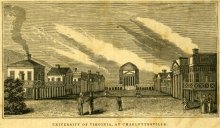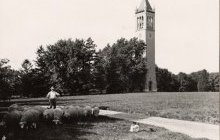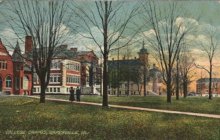 1636 — Harvard founded. It was the first college in the colonies that were to become the United States. It roughly followed the model of Cambridge and Oxford in England (two of the world’s oldest institutions), as the Massachusetts Bay Colony had many residents who attended those schools. To a large degree, Harvard focused on training clergymen in order “to advance learning and perpetuate it to posterity, dreading to leave an illiterate ministry to the churches.” Training clergymen wasn’t the only emphasis though; of Harvard’s first 500 graduates, only about half went into ministry. There were other possible studies that could lead to careers as public officials, physicians, lawyers — other leadership roles in local communities. Students of early Harvard were studying a largely classical (what we’d now call liberal arts) curriculum of Latin, Greek studies, civic law, theology, etc.
1636 — Harvard founded. It was the first college in the colonies that were to become the United States. It roughly followed the model of Cambridge and Oxford in England (two of the world’s oldest institutions), as the Massachusetts Bay Colony had many residents who attended those schools. To a large degree, Harvard focused on training clergymen in order “to advance learning and perpetuate it to posterity, dreading to leave an illiterate ministry to the churches.” Training clergymen wasn’t the only emphasis though; of Harvard’s first 500 graduates, only about half went into ministry. There were other possible studies that could lead to careers as public officials, physicians, lawyers — other leadership roles in local communities. Students of early Harvard were studying a largely classical (what we’d now call liberal arts) curriculum of Latin, Greek studies, civic law, theology, etc.
1693 — It took almost 60 more years for a second college to be founded, William & Mary. It was an Anglican institution, and required students to be members of the Church of England. In addition, professors had to declare their adherence to the Thirty-Nine Articles. While you could study philosophy as well as “natural” philosophy (math, physics, etc.), this education was mostly in preparation to become a minister.
While you could study philosophy as well as “natural” philosophy (math, physics, etc.), this education was mostly in preparation to become a minister.
1700 — Tuition is up to about 10 shillings per quarter, which amounted to the cost of about a pair of shoes and two pairs of stockings. This cost was not prohibitive for most families. So, why didn’t more people go to college? It was more about practicality. The family farm or business could ill afford to lose an able-bodied young man for a period of multiple years. It not only was a couple years of lost income, but when living costs were factored in for students (almost entirely paid for by parents), the cost just was not worth it for the vast majority of colonists. It was an elite group of people who attended; in fact, for its first 150 years, Harvard graduates were listed by the family’s social rank rather than alphabetically.













